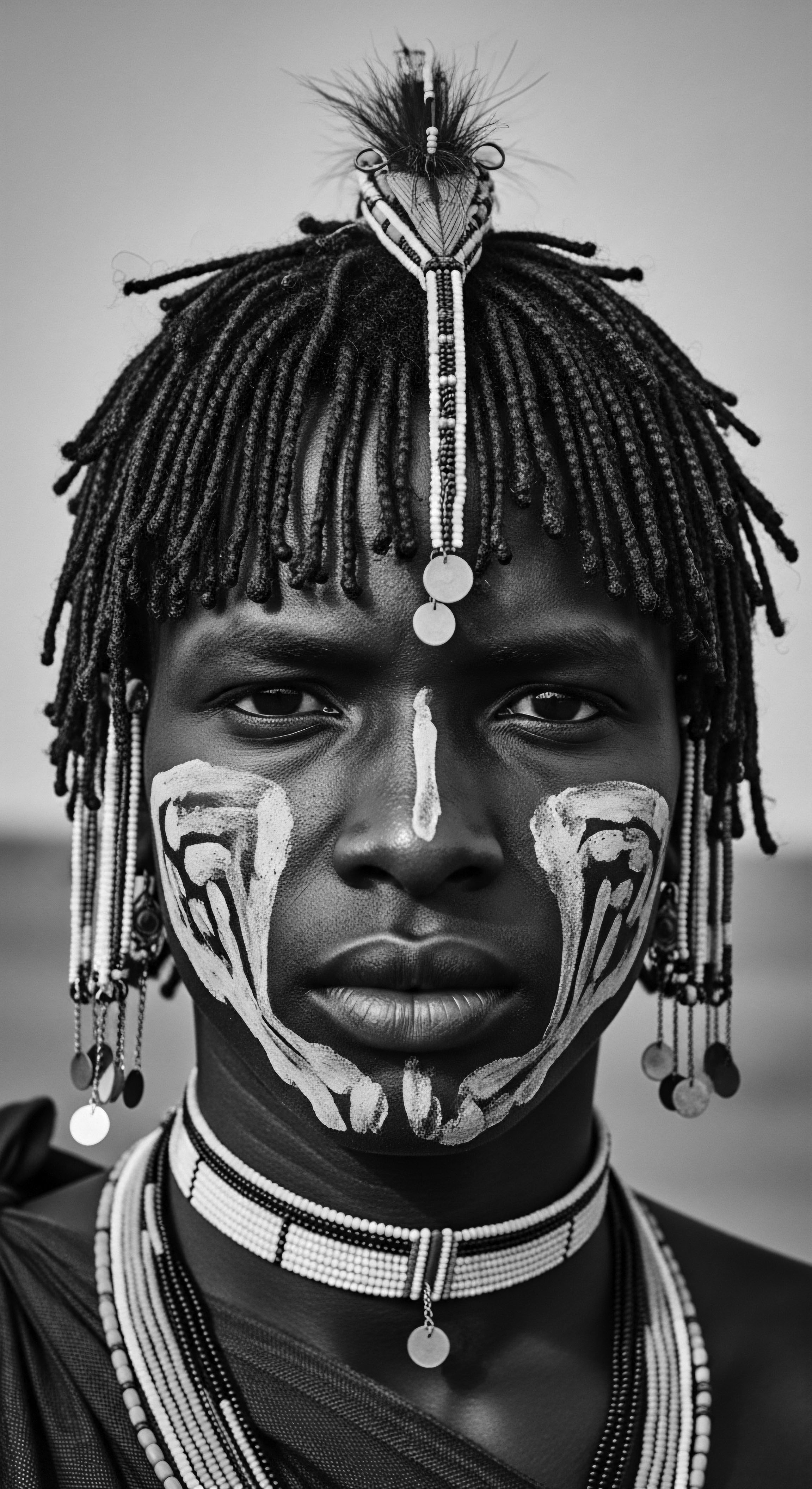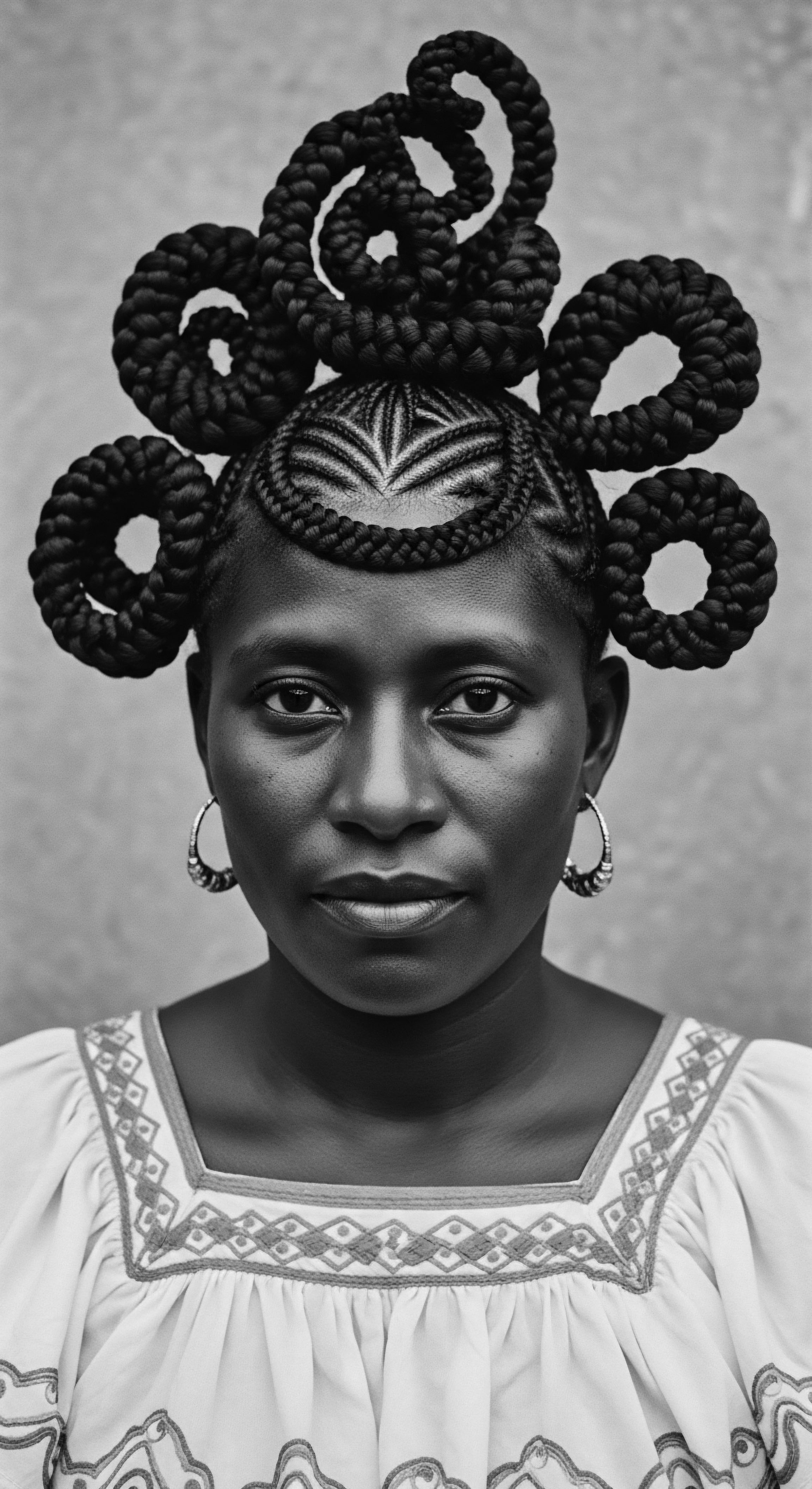
Fundamentals
Traditional Dietary Principles, when viewed through the rich lens of textured hair heritage, represent a profound understanding of how sustenance from the earth connects to our very being, extending even to the vitality of our strands. This concept moves beyond mere caloric intake; it embodies an ancient wisdom recognizing food as a fundamental building block of life, intricately woven with cultural identity, community, and the well-being of the body, including the hair that crowns us. The principles speak to eating in rhythm with the land, valuing whole, unprocessed foods, and employing preparation methods passed down through generations.
For many communities across the African diaspora, and indeed for indigenous peoples globally, these principles were not formal doctrines but lived practices. Ancestors relied on what the land and waters offered, crafting dietary patterns that inherently provided a spectrum of nutrients. These traditional food systems, often defined as all food within a particular culture available from local natural resources and culturally accepted, also include the sociocultural meanings, acquisition and processing techniques, use, composition, and nutritional consequences for the people consuming the food. Such approaches naturally supported robust health, influencing everything from the strength of bone to the sheen of hair.
Traditional Dietary Principles signify an ancient understanding of how ancestral nourishment directly contributes to the vibrant health and resilience of textured hair.

Echoes from the Source ❉ The Land’s Generosity
Consider the foundational elements of these diets ❉ the verdant greens, hearty grains, lean proteins, and diverse fats indigenous to specific regions. In many African traditional diets, for instance, staples like yams, plantains, and nutrient-dense leafy greens such as spinach, ugu (pumpkin leaves), and amaranth formed the core. These foods provided essential vitamins like A and C, crucial for sebum production and collagen creation, which both contribute to hair strength. Healthy fats, from sources like palm oil or avocados, were also integral, contributing to overall health, including that of the skin and hair.
Understanding these principles is a step toward honoring the wisdom of those who came before us. It suggests that our hair, a biological marvel, thrives when nourished from the inside, mirroring the external care rituals that have always been central to Black and mixed-race hair traditions. Nourishment, it is clear, has always had to come from the inside out for hair to truly flourish.

Building Blocks ❉ Essential Nutrients
- Proteins ❉ Hair, primarily composed of keratin, requires sufficient protein intake for structural integrity and growth. Traditional diets frequently included lean meats, fish, and a variety of beans and legumes. For example, beans are a significant plant-based source of protein, alongside zinc, which aids in hair growth and repair.
- Vitamins and Minerals ❉ Communities historically consumed foods rich in Vitamin A (from sweet potatoes and leafy greens), Vitamin C (from fruits and vegetables like red bell peppers), and B vitamins (found in fermented foods and whole grains). Iron, abundant in leafy greens and certain legumes, promotes healthy hair growth by assisting red blood cells in oxygen transport to hair follicles.
- Healthy Fats ❉ Sources such as nuts, seeds, coconut, and avocado were regular dietary components, supplying essential fatty acids and antioxidants that contribute to hair quality and scalp health.
| Nutrient Category Protein |
| Ancestral Food Sources (Examples from African/Caribbean Heritage) Fatty fish (mackerel, sardines), beans, lentils, indigenous poultry, lean meats |
| Nutrient Category Vitamins (A, C, E, B) |
| Ancestral Food Sources (Examples from African/Caribbean Heritage) Sweet potatoes, leafy greens (spinach, ugu), red bell peppers, citrus, fermented foods |
| Nutrient Category Minerals (Iron, Zinc) |
| Ancestral Food Sources (Examples from African/Caribbean Heritage) Leafy greens, beans, nuts, seeds, oysters |
| Nutrient Category Healthy Fats |
| Ancestral Food Sources (Examples from African/Caribbean Heritage) Avocado, coconut, palm oil, nuts, seeds |
| Nutrient Category These dietary components illustrate the holistic approach to nourishment found in traditional foodways, supporting hair's very foundation. |

Intermediate
Moving beyond the simple enumeration of ingredients, an intermediate understanding of Traditional Dietary Principles reveals a complex system of interconnected practices. It encompasses not only what was eaten, but how food was sourced, prepared, and shared within community structures. This perspective highlights the inherent balance and ecological harmony that characterized ancestral foodways, influencing health at a systemic level, including the often-overlooked health of the scalp and hair.
The significance of these principles extends to understanding food as a cultural language, spoken through ingredients, cooking methods, and shared meals. Different cultures expressed themselves distinctly through their cuisine, and these practices offer insights into a culture’s values, beliefs, and its relationship with the natural world.
Traditional Dietary Principles illuminate ancestral food systems as balanced ecosystems of nourishment, fostering not only physical well-being but also a deep, intrinsic connection to cultural identity and collective health.

The Tender Thread ❉ Living Traditions of Care and Community
Ancestral peoples, particularly those with textured hair lineages, often engaged in food preparation techniques that amplified nutrient availability. Fermentation, for example, a time-honored practice across numerous cultures, breaks down complex nutrients, making them more bioavailable. This process renders minerals like iron and zinc, vital for robust hair growth, more easily absorbed.
Fermented foods, such as certain traditional African brews or dishes, contributed to a healthy gut microbiome, which, in turn, supports the absorption of essential vitamins and minerals crucial for hair health. The interconnection between gut health and hair appearance is indeed undeniable.
Beyond nutritional chemistry, these dietary patterns were deeply entwined with communal life. Food was often cultivated, harvested, and prepared collectively, cementing social bonds and transmitting generational knowledge. The communal table became a sacred space where stories, traditions, and resilience were shared. Such collective engagement with food fostered not only physical sustenance but also spiritual and emotional well-being, aspects equally vital for a vibrant self, and by extension, vibrant hair.

Culinary Wisdom ❉ Preparation and Synergy
- Fermentation ❉ This ancient method, present in diverse cultures, enhances nutrient absorption by breaking down food substances into more absorbable forms. Examples in hair health include its role in making iron and zinc more bioavailable, both critical for hair strength.
- Whole-Food Focus ❉ Traditional diets emphasized unrefined, whole foods. This minimized exposure to processed ingredients that lack the full spectrum of nutrients and often contain additives detrimental to overall health, including hair vitality.
- Seasonal and Local Eating ❉ Eating according to seasonal cycles and consuming locally sourced foods ensured freshness and nutrient density. This practice also aligned with environmental sustainability, demonstrating a deep respect for the land that provided sustenance.

Diasporic Adaptations ❉ Sustaining Heritage Through Food
The forced migrations and displacements endured by Black communities during the transatlantic slave trade profoundly disrupted traditional African food systems. Yet, even in the crucible of oppression, remarkable adaptations occurred. Enslaved Africans carried knowledge of planting and cultivation, recreating familiar ingredients where possible, or adapting ancestral dietary principles to new environments and available resources. For instance, the use of indigenous greens, root vegetables, and pulses in the Caribbean diet reflects a continuation and adaptation of these principles, offering sustained energy and supporting overall health, including skin and hair quality through elements like avocado.
This capacity to adapt while retaining the spirit of ancestral nourishment speaks volumes about the resilience of Black culinary heritage. The foodways that emerged in the diaspora, like elements of Caribbean cuisine, reflect a fusion of diverse influences, always striving for balance and sustenance, often under challenging circumstances. Traditional Caribbean diets, for instance, are naturally balanced, aligning with modern health principles by being high in fiber, anti-inflammatory agents, plant-based proteins, and healthy fats, while being low in processed foods.
| Region/Community West Africa |
| Key Traditional Food Elements Yams, plantains, leafy greens (ugu, amaranth), palm oil, indigenous spices, fatty fish, beans. |
| Connection to Hair Health Rich in Vitamin A, C, iron, protein, and healthy fats, supporting scalp health, collagen production, and hair growth. |
| Region/Community Caribbean |
| Key Traditional Food Elements Callaloo, yams, breadfruit, pigeon peas, black-eyed peas, brown rice, coconut, avocado, turmeric, ginger. |
| Connection to Hair Health High in fiber, plant-based protein, healthy fats, and antioxidants, contributing to overall vitality and hair quality. |
| Region/Community Indigenous North America (e.g. Yup'ik) |
| Key Traditional Food Elements Wild foods, marine mammals, fish (salmon, caribou in Arctic regions). |
| Connection to Hair Health Specific chemical signatures in hair samples link to diets rich in traditional foods, hinting at long-term health benefits, potentially including hair. |
| Region/Community These examples highlight the diverse yet unifying thread of indigenous nourishment, each adapting to its unique environment while upholding principles beneficial for holistic well-being. |

Academic
A rigorous academic examination of Traditional Dietary Principles reveals an intricate interplay of nutritional science, cultural anthropology, and historical sociology, particularly when its meaning is contextualized within the ancestral foundations of textured hair care. The definition extends beyond a mere list of foods, encompassing the systemic organization and functioning of food complexes, the pressures influencing food choices, and the profound sociocultural and ecological underpinnings of dietary practices. It signifies a comprehensive understanding of human sustenance that prioritizes nutrient density, ecological harmony, and communal well-being, often demonstrating superior health outcomes when compared to modern, industrialized dietary patterns. This deep analytical perspective allows us to clarify the inherent wisdom within these ancient practices, often validated by contemporary scientific inquiry.
The meaning of Traditional Dietary Principles, therefore, refers to the inherited and learned representations, beliefs, knowledge, and practices associated with food and shared by individuals within a specific cultural or social group. Such systems are intrinsically tied to local natural resources and culturally accepted methods, contributing significantly to the nutritional and overall health consequences for the populations adhering to them. For those tracing their lineage through Black and mixed-race ancestries, these principles are not just historical footnotes; they are living archives of resilience, codified in the very biology and aesthetic of textured hair.
Traditional Dietary Principles embody a complex matrix of ancestral knowledge, ecological adaptation, and communal practice, offering a scientifically compelling and culturally profound model for holistic well-being, intrinsically linked to the inherent strength and beauty of textured hair.

Bio-Ancestral Syncretism ❉ Nutrient Pathways to Hair Integrity
The biological mechanisms through which Traditional Dietary Principles supported healthy textured hair are multifold and sophisticated. Hair follicles, among the most metabolically active tissues in the body, demand a consistent supply of macronutrients and micronutrients to sustain their rapid growth cycles. Ancestral diets, by their very nature, were replete with the specific building blocks necessary for robust hair.
Consider the profound role of protein. Hair is predominantly composed of keratin, a protein. Diets rich in complete proteins from sources such as lean meats, fatty fish like mackerel and sardines, and diverse legumes provided ample amino acids for keratin synthesis. Protein malnutrition, historically, has been associated with marked changes in hair structure, including thinning and loss.
Beyond protein, the array of vitamins and minerals found in unadulterated traditional foods played critical parts. Vitamin A, derived from beta-carotene in vibrant leafy greens and sweet potatoes, supported the production of sebum, the scalp’s natural moisturizer, vital for lubricating coily and kinky hair types prone to dryness. Vitamin C, abundant in various traditional fruits and vegetables, was not only key for iron absorption but also instrumental in collagen production, a structural protein contributing to the strength and elasticity of hair strands.
The significance of micronutrients extends further to trace elements. Zinc, found in legumes, nuts, and certain animal proteins, is a cofactor for numerous enzymes involved in hair follicle function and growth. Iron, a widespread deficiency in modern diets, was historically supplied through dark leafy greens, beans, and meat, ensuring adequate oxygen transport to the highly active hair follicles. Deficiencies in these elements directly impact hair growth cycles and overall hair quality.

Microbial Ecology and Nutrient Bioavailability
The ingenuity of ancestral food preparation methods often maximized nutrient bioavailability. Fermentation, for example, a practice deeply embedded in many global food cultures, including those of Africa, facilitated the breakdown of complex carbohydrates and proteins into more digestible forms, simultaneously increasing the concentrations of beneficial compounds. This bioconversion process renders nutrients more easily absorbed by the body, allowing for greater utilization by tissues such as the hair follicle.
Research on fermented foods like kimchi and kefir highlights their capacity to improve nutrient absorption, especially for minerals like iron and zinc, while also supporting a balanced gut microbiome. A healthy gut microbiome, in turn, influences the absorption of vitamins and minerals essential for hair growth, underpinning a powerful internal synergy that ancestral diets inherently fostered.
Additionally, the traditional reliance on healthy fats from indigenous plant sources like shea butter (often consumed as food-grade oil in some regions), coconut, and avocado provided essential fatty acids that contribute to the integrity of cell membranes, including those of the scalp and hair follicles. These fats, alongside their nutritional contribution, were often used topically, showcasing a holistic view where internal nourishment and external care were not distinct but complementary facets of well-being.

Diasporic Echoes ❉ Adaptations of Sustenance
The transatlantic slave trade precipitated a profound dietary rupture for enslaved Africans, stripping them of traditional food systems and forcing reliance on meager provisions. Despite these devastating circumstances, ancestral dietary principles did not vanish; instead, they transformed. Enslaved communities adapted, drawing on fragmented memories of traditional foods and ingenious cultivation techniques, incorporating new ingredients available in the Americas. This period saw the emergence of new culinary traditions, often born of necessity and resilience, which nevertheless carried faint echoes of the original dietary wisdom.
For example, in the Caribbean, communities preserved and adapted their knowledge of nutrient-dense vegetables, root crops like yams and cassava, and legumes such as pigeon peas and black-eyed peas. These foods, despite the changed context, remained foundational for providing energy and essential micronutrients. The continuation of practices like consuming brown rice, cornmeal, and local grains reflects a sustained preference for complex carbohydrates and fiber, contributing to sustained energy and digestive health. This ability to integrate diverse ingredients while retaining a focus on whole, plant-forward foods demonstrates an enduring ancestral dietary intelligence.
However, the imposed colonial diet also brought detrimental shifts. Historical accounts from early colonial Spanish America illustrate how European colonizers often viewed indigenous diets as “inadequate,” linking them to perceived physical differences, including hair texture. This colonial gaze often dismissed the nutritional completeness of diverse indigenous foodways, contributing to a devaluation of traditional practices.
The long-term consequences of this dietary shift, particularly for populations of African descent, are still felt today, manifesting in higher rates of diet-related health issues. Reclaiming ancestral diets has become a movement to address these historical health disparities.
One compelling, perhaps less commonly cited, illustration of the profound connection between Traditional Dietary Principles and textured hair heritage emerges from studies on Indigenous Populations in Canada. The First Nations Food, Nutrition and Environment Study (FNFNES), a decade-long collaborative effort, meticulously examined the dietary patterns, food security status, and environmental health of First Nations communities. This comprehensive research included hair sampling for mercury exposure and nutritional analysis, alongside detailed dietary interviews.
The study’s findings reveal a stark contrast ❉ traditional foods were consistently preferred over store-bought alternatives, not only for their cultural significance but also for their superior nutritional quality. Furthermore, the inclusion of traditional foods significantly improved diet quality within these communities. However, the study also underscored a tragic consequence of colonization ❉ over half of all First Nation adults reported that the harvesting of traditional foods was impacted by industry-related activities and climate change, leading to a decline in their consumption. The disruption of these intricate, ecologically embedded food systems has had severe ramifications, contributing to widespread food insecurity and nutritionally inadequate diets in many First Nations communities.
This case, though focused on Indigenous Canadian communities, provides a powerful analogue for the Black and mixed-race experience. It underscores how the erosion of traditional food access—whether through displacement, slavery, or environmental degradation—directly compromises nutritional well-being at a fundamental level, which, given the metabolic demands of hair follicles, would inevitably affect hair health and vitality. The chemical signatures found in human hair have been linked to a diet of traditional Yup’ik foods, providing tangible evidence of the dietary impact on physiological markers. The decline in quality or availability of traditional foods can lead to observable physical changes, such as reduced animal size or deformities, mirroring the potential for human physiological impact, including hair health.
The link is clear ❉ when ancestral food systems, rich in diverse, bioavailable nutrients, are disrupted, the very cellular processes that sustain healthy hair are compromised. The FNFNES provides quantifiable evidence that shifts away from Traditional Dietary Principles, enforced by external pressures, correlate with diminished dietary quality, offering a scientific lens through which to comprehend the historical challenges faced by textured hair communities in maintaining ancestral hair vibrancy.

Reclaiming the Table ❉ Modernity and Ancestral Wisdom
Contemporary understandings of Traditional Dietary Principles in the context of textured hair extend to movements aimed at reclaiming ancestral foodways. The concept of a “decolonized diet,” which involves consuming foods as Indigenous and Black people ate prior to colonialism, has gained traction as a social movement. This is more than a culinary preference; it is a profound act of cultural reclamation and health empowerment.
The recognition that many “traditional” African American dishes have roots in forced dietary adaptations during slavery, often utilizing undesirable leftovers from slave owners, highlights the complex history embedded in diasporic cuisine. Soul food, while cherished, often incorporates fatty and salty ingredients, a stark departure from the nutritionally complete pre-colonial African diets. By consciously shifting back to whole, plant-forward foods, lean proteins, and healthy fats characteristic of ancient African diets, individuals can mitigate some of the health issues that disproportionately affect communities of African descent, including those impacting hair.
The challenge lies in integrating these principles into modern life. Globalization has made many traditional ingredients more accessible, yet economic factors and convenience often steer dietary choices away from ancestral paths. Food revival movements, however, are demonstrating the potential for adapting this wisdom, fostering a deeper connection to heritage.

Ethical Considerations and Long-Term Flourishing
An academic discussion of Traditional Dietary Principles also entails ethical considerations. It involves understanding the historical trauma associated with the colonization of indigenous peoples and the disruption of their traditional food systems. Addressing food insecurity among Indigenous peoples requires culturally specific and integrated approaches that account for food availability, cost, knowledge, safety, and quality. This perspective resonates deeply with the need to support and celebrate the dietary heritage of Black and mixed-race communities, acknowledging that food justice is inextricably linked to hair wellness.
The long-term consequences of departing from these principles underscore the inherent wisdom of ancestral practices. Diseases linked to poor diet, like obesity, diabetes, and heart disease, are prevalent in communities whose traditional food systems were disrupted. The epigenetic factors in conditions like androgenetic alopecia suggest that negative lifestyle and dietary factors can potentially be reversed, linking diet to even inherited hair patterns.
By returning to diets rich in vitamins, minerals, antioxidants, and adequate protein, individuals can support hair growth and density, reducing issues like hair loss. The very act of re-engaging with Traditional Dietary Principles, therefore, extends beyond personal health; it represents an act of ancestral honoring and a commitment to collective flourishing for future generations.
The research into fermented tropical fruits and their impact on hair quality, for instance, offers a modern scientific validation of traditional methods. Studies indicate that plant-derived metabolites and microbial exometabolites from fermented fruits can act as highly bioavailable biomolecules, supporting anti-inflammatory and hair growth-promoting effects. This convergence of ancient practice and contemporary science provides powerful evidence for the enduring relevance of Traditional Dietary Principles for textured hair care.

Reflection on the Heritage of Traditional Dietary Principles
The exploration of Traditional Dietary Principles, particularly through the prism of textured hair heritage, is more than an academic exercise; it is a profound meditation on the enduring soul of a strand. Our hair, in its myriad coils, kinks, and waves, carries the narratives of generations—tales of survival, adaptation, and an unwavering connection to the earth and its bounty. These principles, passed down through the subtle currents of shared meals and inherited wisdom, whisper stories of resilience in every burgeoning follicle and every resilient curl. They remind us that the health of our hair is not a superficial concern but a reflection of a deeper, holistic well-being, intimately linked to the nutritional legacies of our forebears.
As sensitive historians of Black and mixed-race hair traditions, we find that the journey from elemental biology to vibrant identity is paved with the choices made at ancestral tables. The traditional dietary patterns, rich in the earth’s honest offerings, speak to a world where nourishment was intuitively aligned with the body’s needs, long before scientific laboratories could articulate the precise role of each vitamin or mineral. This ancestral understanding, honed over millennia, is a testament to the innate wisdom embedded within diverse cultural food systems.
In honoring these principles, we do not merely seek a return to the past. We seek a profound recognition of its profound influence, allowing its gentle guidance to inform our present choices. This understanding empowers us to see our textured hair not just as a crown, but as a living, breathing archive—a testament to the strength, beauty, and unwavering spirit of those who sustained themselves, and their descendants, through the pure gifts of the land. The path forward, then, involves a harmonious blending of ancient wisdom with modern insight, ensuring that the legacy of vibrant, well-nourished textured hair continues to flourish for generations yet to come.

References
- Kuhnlein, Harriet V. and Receveur, Olivier. “Dietary Change and Traditional Food Systems of Indigenous Peoples.” ResearchGate, Annual Review of Nutrition, 1996.
- O’Brien, Diane, et al. “Diet of traditional Native foods revealed in hair samples.” ScienceDaily, University of Alaska Fairbanks, 25 July 2019.
- Plummer, Nicole, and Rognmo, Thomas. “Diet, Health and Beauty in Early Jamaica, 1700-1900.” ResearchGate, University of the West Indies, Mona, 20 Jan. 2022.
- Mihesuah, Devon Abbott. Recovering Our Ancestors’ Gardens ❉ Indigenous Recipes and Guide to Decolonized Eating. University of Nebraska Press, 2020.
- Hernández, Francisco. Historia Natural de Nueva España. Cited in Pardo, Sara. “If You Eat Their Food …” ❉ Diets and Bodies in Early Colonial Spanish America. Oxford Academic, 1 June 2010.
- Katsonga-Woodward, Heather. “The Best Foods For Hair Growth.” pan-African, 4 Mar. 2021.
- Abad, Luis, et al. “Biomolecules of Fermented Tropical Fruits and Fermenting Microbes as Regulators of Human Hair Loss, Hair Quality, and Scalp Microbiota.” MDPI, 20 Apr. 2023.
- Irobi, Amarachi. “Here are 10 Magical Foods For Hair Growth.” pan-African, 24 Jan. 2022.
- Lakpah, Victoria. “Top 10 African foods for healthy hair.” DatelineHealth Africa, 4 June 2025.
- Mihigo, Jean-Claude. “Putting indigenous foods and food systems at the heart of sustainable food and nutrition security in Uganda.” International Institute for Environment and Development (IIED), 2019.
- The First Nations Food, Nutrition & Environment Study (FNFNES). “Decade-long, mega-study finds barriers to access to healthy traditional foods are eroding food security for First Nations.” First Nations Food, Nutrition and Environment Study, 7 Nov. 2019.
- Osei, D.K. “One of the classic food taboos I knew about whilst growing up in Ghana was that when children were fed eggs, they grew up to become thieves.” WPHNA World Public Health Nutrition Association, 1 Apr. 2011.
- Limmer, Jennifer and Sherwood, Allison. “The Impact of Diet and Nutrition on Hair Health and Hair Loss.” Limmer Hair Transplant Center, 12 July 2024.
- Oyetayo, V.O. “Traditional African Secrets For Long And Healthy Hair.” Africa Imports, 4 June 2021.
- Katsonga-Woodward, Heather. “Achieving Natural Hair Growth in South Africa.” O’Right, 23 Sep. 2024.
